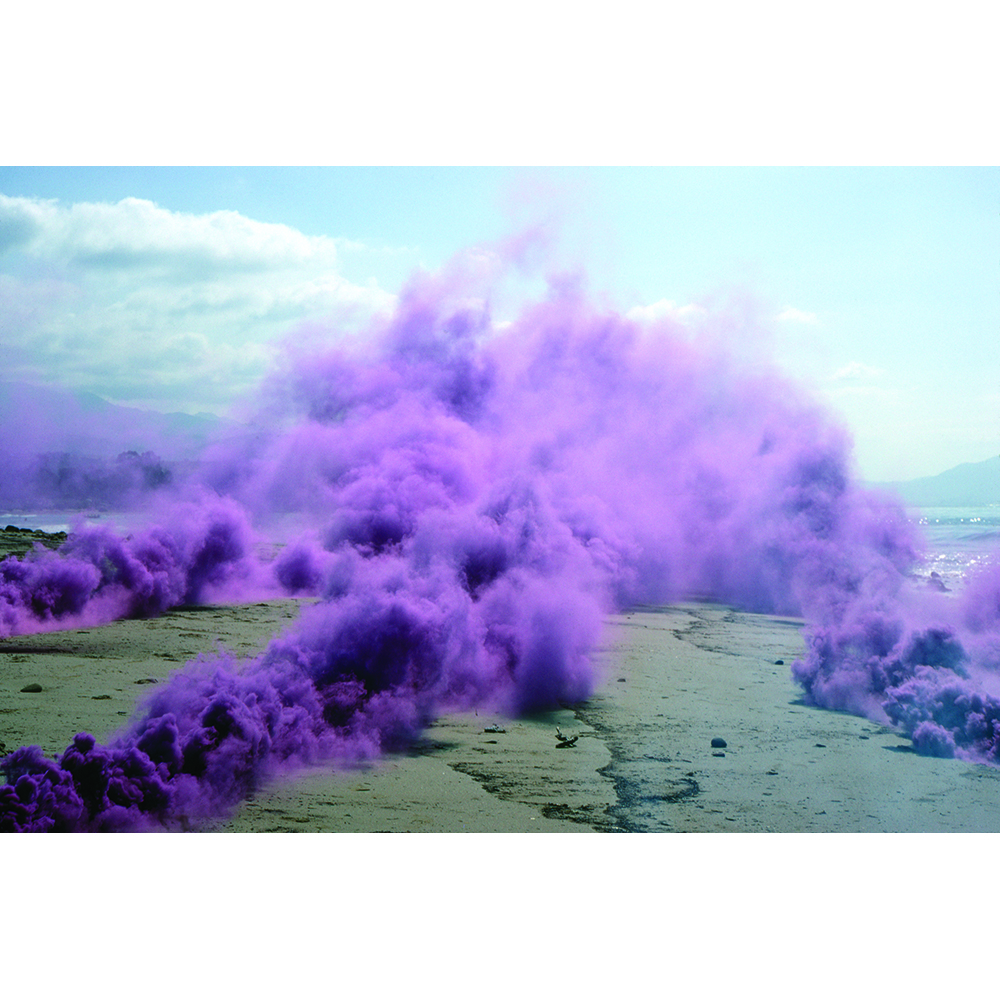Artwork Description
Judy Chicago – Purple Atmosphere
Dimensions: 48 x 72″ finished size / 48 x 72″ unframed
Year: 1969, 2019
Medium: ChromaLuxe metal print on aluminum
Edition: 1/3, 2 APs
Judy Chicago’s Purple Atmosphere is a contemporary two-dimensional iteration of her colored smoke atmospheres of the 1970s. As is the case with virtually every series/concept Chicago has embraced, the concept remains in her psyche and she revisits the concept throughout her career, considering it in all types of media she desires to explore. From monumental smoke atmospheres to more humanly scaled photographic referential works on paper or aluminum, her concept takes on different attributes specific to the respective material. In the case of this work, Chicago’s atmospheric “poem” for the Earth is as powerful and beautiful on a small scale as it was on a monumental outdoor scale, like the same voice but with a different accent.
Chicago is a performative land artist in one manner, but when she creates her land art, as she takes care to add softness and beauty to it, as if she is “feminizing” the environment with her work. Her Purple Atmosphere’s softly colored smoke sits gently between heaven and earth, as if bathing it in color. While the performative work was an extension of the feminine color palette of Chicago’s early works, she has carried this concept into all of her works throughout her career. Recently, Chicago’s atmospheres and smoke and pyrotechnic works have been revitalized by numerous commissions at museums worldwide. As is the case with much of Chicago’s work, it sometimes takes society and the art world a few decades to fully embrace the genius of her radically innovative works.
-Tonya Turner Carroll
Judy Chicago is a pioneer of feminist art since the early 1970s, Judy Chicago advocates issues of women’s liberation and independence through diverse media including paintings, drawings, sculptures, and collaborative installations. Her iconic work “The Dinner Party,” (1974—1979), which is now permanently installed in the Brooklyn Museum of Art’s Elizabeth A. Sackler Center for Feminist Art, is widely regarded as one of the most influential works of feminist art. With Miriam Schapiro, Chicago co-founded the Feminist Art Program at the California Institute of the Arts—the first program of its kind—and collaborated on the formative installation Womanhouse (1972). More recently, Chicago has expanded upon her efforts in gender politics, focusing on broader social issues. Her work has been exhibited extensively at venues such as the Los Angeles Museum of Contemporary Art, the New Museum, the Centre Pompidou, the Whitney Museum, and the Jewish Museum in New York.
Judy Chicago speaks of her work as “trying to infuse women and women’s history with a sense of the sacred and the valuable, because there are all these things associated with women that have been devalued: our bodies, our crafts, our history,” continuing on to say she “tried to bring the same thing to bear on [her] work.”
Judy Chicago is a pioneer of feminist art. Since the early 1970s, Judy Chicago advocates issues of women’s liberation and independence through diverse media including paintings, drawings, sculptures, and collaborative installations. Her iconic work “The Dinner Party,” (1974—1979), which is now permanently installed in the Brooklyn Museum of Art’s Elizabeth A. Sackler Center for Feminist Art, is widely regarded as one of the most influential works of feminist art. With Miriam Schapiro, Chicago co-founded the Feminist Art Program at the California Institute of the Arts—the first program of its kind—and collaborated on the formative installation Womanhouse (1972). More recently, Chicago has expanded upon her efforts in gender politics, focusing on broader social issues. Her work has been exhibited extensively at venues such as the Los Angeles Museum of Contemporary Art, the New Museum, the Centre Pompidou, the Whitney Museum, and the Jewish Museum in New York.
Judy Chicago speaks of her work as “trying to infuse women and women’s history with a sense of the sacred and the valuable, because there are all these things associated with women that have been devalued: our bodies, our crafts, our history,” continuing on to say she “tried to bring the same thing to bear on [her] work.”

